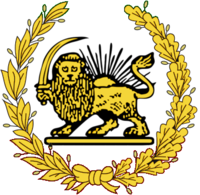Coat of arms of Iran
From Wikipedia, the free encyclopedia
| Coat of Arms of Islamic Republic of Iran | |
|---|---|
 |
|
| Details | |
| Adopted | 1980 |
| Motto | Name of Allah. |
| Use | Official Seal of Iran, Ministries and others |
The coat of arms of Iran (نشان رسمی ایران) since the 1979 Iranian Revolution features a stylized Perso-Arabic script of the word Allah ("God").
The logo consists of four crescents and a sword. The four crescents are meant to stand for the word Allah. The five parts of the emblem symbolize the Principles of the Religion. Above the sword is a shadda: in Arabic script, this is used to double a letter. The shape of the emblem is chosen to resemble a tulip, for the memory of the people who died for Iran: it is an ancient belief in Iran, dating back to mythology, that if a young soldier dies patriotically a red tulip will grow on his grave. In recent years it has been considered the symbol of martyrdom.
The logo was designed by Hamid Nadimi, and was officially approved by Ayatollah Ruhollah Khomeini founder of Islamic Republic of Iran on May 9, 1980.
The logo is encoded in Unicode, in the Miscellaneous Symbols range, at codepoint U+262B (☫) under the name "FARSI SYMBOL".[1] It is unclear why it was included in Unicode 1.0 since technically it is a logo, not a character. It is not used in Persian text and is not referred to as "Persian symbol" outside of the Unicode standard.
Contents |
[edit] History
[edit] Achaemenid Empire

During the Achaemenid, especially at the time of Cyrus the Great, the Persian Imperial Flag was made of up of a kinglike image, rectangular in shape, split into four equivalent triangles. Each two of these four train triangles had the same colour.
In the excavations at Persepolis, archaeologists have found a standard, depicting a falcon (shahin) with open wings, regarding which the current belief is that this was the official flag of Iran under the reign of Cyrus the Great and his heirs.
[edit] Farvahar
Faravahar is one of the best-known symbols of Zoroastrianism, a state religion of the ancient Persian Empires despite the fact it had existed well before the creation of that religion. In Iran formerly known as Persia, Zoroastrianism is no longer the official state religion; however, the Faravahar has now come to represent a national Iranian symbol that reflects both ancient and modern Iran. [2][3]. This religious-cultural symbol was adapted by the Pahlavi dynasty to represent the Iranian nation.
The winged disc has a long history in the art and culture of the ancient Near and Middle East. Historically, the symbol is influenced by the "winged sun" hieroglyph appearing on Bronze Age royal seals (Luwian SOL SUUS, symbolizing royal power in particular). In Neo-Assyrian times, a human bust is added to the disk, the "feather-robed archer" interpreted as symbolizing Ashur.
It was only during the reign of Darius I and thereafter, that the symbol was combined with a human form above the wings, perhaps representing Darius himself.
[edit] Qajar Dynasty
After Iranian Constitutional Revolution in 1906, Parliament designed a new flag and a new coat of arms. Lion and Sun motif is one of the better known emblems of Iran, and between 1576 and 1979 was an element in Iran's national flag too .
The motif, which combines "ancient Iranian, Arab, Turkish, and Mongol traditions", became a popular symbol in Iran in the 12th century.[1] The lion and sun symbol is based largely on astronomical and astrological configurations; the ancient zodiacal sign of the sun in the house of Leo,[1][2] which itself is traced backed to Babylonian astrology and Near Eastern traditions.[2][3]
The motif has many historical meanings. First, it was an astrological and zodiacal symbol. Under Safvis and first Qajar kings, it received a specifically Shi'ite interpretation.[1] In Safavid era the lion and sun stood for two pillars of the society, state and religion. It became a national emblem during the Qajar era. In the 19th century, European visitors at the Qajar court attributed the lion and sun to remote antiquity and since then it got a nationalistic interpretation.[1]
During the reign of Fat'h ALi Shah and his successors the motif was substantially changed. These changes were on the form of the lion, the sun. A crown was also placed on the top the symbol to represent the monarchy.
Since the reign of Fat'h Ali Shah Qajar, the Islamic component of the ruler de-emphasized. This shifting affects the symbolism of the emblem. Since this time until the1979 revolution the meaning of the symbol elements changed many times. The lion could be the metaphor for Ali, heroes of Iran who are ready to protect the country against enemies, and finally its ancient meaning, as the symbol of kingship. The Sun received various meanings including the king, Jamshid, the mythical king of Iran, and motherhomeland.
The many historical meanings of the emblem have provided the rich ground for competing symbols of Iranian identity. In 20th century, some politicians and scholars suggested that the emblem should be replaced by other symbols such as Derafsh-e-kaviani. However, the emblem remained the official symbol of Iran until the 1979 revolution, when the "Lion and Sun" symbol was removed from public spaces and government organizations and replaced by the present-day Coat of arms of Iran.
[edit] Imperial State of Iran
In 1925 and after foundation of Imperial State of Iran (also known Pahlavi Dynasty), Reza Shah changed coat of arms of state.He designed a arms with Iran's national and imperial arms.At the top of the coat of arms was the Pahlavi crown, created for the Coronation of Reza Shah in 1926.In the center of arm was 5 national and imperial arms.First Lion and Sun, Second Faravahar, Third Zolfaghar and fourth a tiger cat in mark of power of Iran and in their center was Mount Damavand.In 1960 Shah designed arms for himself and his wife.Imperial Iranian Flags' were the personal standards of the Shah and other members of the Imperial Family of Iran.
The Imperial standard consisted of a pale-blue field with the flag of Iran in the upper left corner and the Pahlavi coat of arms in the centre. Beneath is was the Imperial motto "Mara dad farmud va Khod Davar Ast" ("Justice He bids me do, as He will judge me" or, alternatively, "He gave me power to command, and He is the judge").
Pale blue was the colour of the Imperial Family.That was Iran's Imperial Arms until Iranian Revolution in 1979.
[edit] Islamic Republic of Iran
After Iranian Revolution in 1979 and foundation of Islamic Republic in Iran, Coat of arms and flag of state was changed.Current coat of arms is features a stylized Perso-Arabic script of the word Allah ("God").
The logo consists of four crescents and a sword. The four crescents are meant to stand for the word Allah. The five parts of the emblem symbolize the Principles of the Religion. Above the sword is a shadda: in Arabic script, this is used to double a letter. The shape of the emblem is chosen to resemble a tulip, for the memory of the people who died for Iran: it is an ancient belief in Iran, dating back to mythology, that if a young soldier dies patriotically a red tulip will grow on his grave. In recent years it has been considered the symbol of martyrdom.
The logo was designed by Hamid Nadimi, and was officially approved by Ayatollah Ruhollah Khomeini founder of Islamic Republic of Iran on May 9, 1980.
The logo is encoded in Unicode, in the Miscellaneous Symbols range, at codepoint U+262B (☫) under the name "FARSI SYMBOL".[4] It is unclear why it was included in Unicode 1.0 since technically it is a logo, not a character. It is not used in Persian text and is not referred to as "Persian symbol" outside of the Unicode standard.
[edit] References
- ^ a b c d Shahbazi, A. Shapur (2001). "Flags". Encyclopedia Iranica. Vol. 10. http://www.iranica.com/newsite/index.isc?Article=http://www.iranica.com/newsite/articles/unicode/v9f2/v9f222.html.
- ^ a b H. Kindermann "Al-Asad" Encyclopedia of Islam, Vol.1, p. 681
- ^ Krappe, Alexander H. (Jul. - Sep., 1945). "The Anatolian Lion God". Journal of the American Oriental Society 65, (3): 144–154. http://www.jstor.org/stable/595818.



